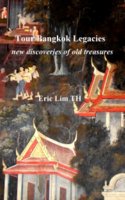| Back to Back Issues Page |
 |
|
Bangkok Travelbug November 15 Mahasawat Canal boat tour Nakhon Pathom October 29, 2015 |
| Hello
History of the Mahasawat Canal In 1860 during the reign of King Rama IV (1851 – 1868), a canal was dug linking the Bangkok Noi Canal to the Nakhon Chaisri River* in Nakhon Pathom, a province just north-west of Bangkok. From the river, a network of canals linked up to Nakhon Pathom city. This was done to facilitate travel from Bangkok to Wat Phra Pathom Chedi in Nakhon Pathom city at a time when there were few roads. Chinese labourers dug this canal which was 27 km long which improved irrigation in the area thereby increasing the arable land. The canal served as a route of movement for people and agricultural produce to Bangkok. 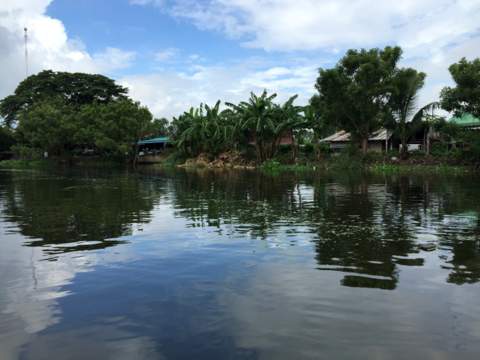
Mahasawat Canal today Several sala (pavilions) were built along the canal about every 4 km. These pavilions had quaint names based on their functions; sala ya – a first aid station (ya – medicine), sala sop - where the dead were placed (sop – corpse, the name was later changed to Thammasop) and sala din – presumably where the earth from the canal was dumped (din – earth). The surrounding areas and communities have since adopted these names, Salaya, Thammasop, Saladin. For more on what this area was like before, please see Thawi Watthana Museum. *Note – The Nakhon Chaisi River is actually the section of the Tha Chin River that passes through the Nakhon Chaisi area. It’s common practice to change the names of rivers and waterways according to the areas they pass through. The Tha Chin River is a tributary of the Chao Phraya and branches off from Chai Nat 170 km north of Bangkok. It flows through Chai Nat, Suphanburi, Nakhon Pathom and enters the Gulf of Thailand at Samut Sakhon. In the 19th C, many Chinese trading junks anchored at the estuary of this river and as a result Samut Sakhon at the estuary was called Tha Chin (Chinese port), a name still in use today. The river was also given the same name. Table of contents Agrotourism by the Mahasawat Canal Agrotourism is defined as a form of travel which encourages visitors to experience agricultural life at first hand, where visitors have the opportunity to work alongside real farmers. A broader definition is to visit a working farm to enjoy the atmosphere, be educated on the functions of farming and if you like, be involved in the activities. Before you get frightened off by thoughts of being up to your knees and elbows in muddy waters, relax. For this visit, you’re only going to visit the farms, learn about them, taste some of their products and buy some home if you like to help farmers supplement their income. Long-tailed boat tours are organised by the Phuttamonthon district of Nakhon Pathom province to familiarise visitors with farm life along the historic Mahasawat Canal and give farmers a chance to augment their income by selling some of their processed products. 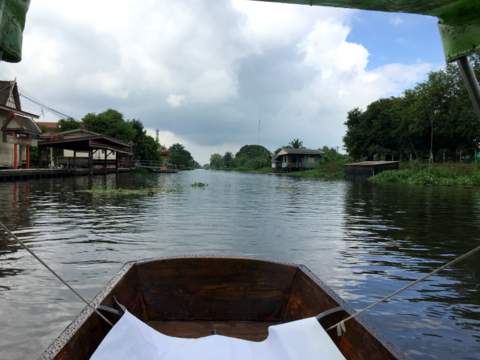
From the bow of the long-tailed boat These boat tours start and finish at Wat Suwannaram where there is a ticket and information booth for the long-tailed boat tours. Let’s start our tour. Table of contents Lotus farm To get to our first stop, we had to leave the main canal and enter a narrow tributary which eventually brought us to this lotus farm which is about 15 rai (2.4 hectares or 5.93 acres). Lotus plants of the water species are grown in a huge pond. 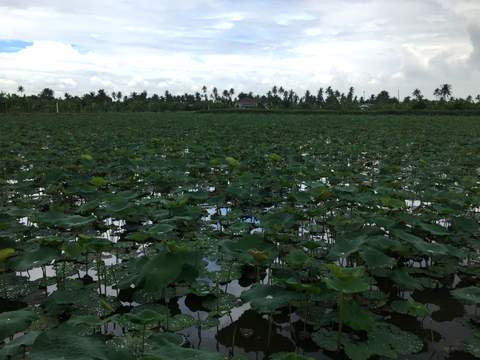
The lotus pond At the pavilion, we got into a boat rowed by our guide which took us through the pond filled with lotus plants. These lotus flowers mostly bloom during the hot season from April – June and as our visit was in October during the rainy season we were unable to view any flowers in full bloom. 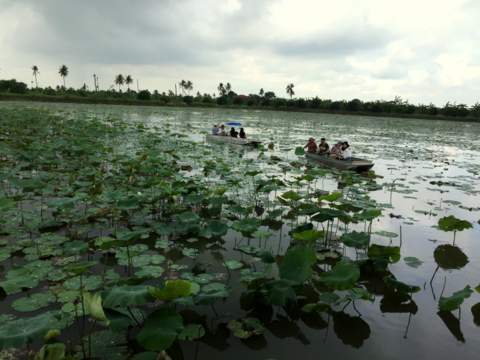
Rowing a boat through the lotus After the lotus flowers have been harvested, the water from a section of the pond is partially drained. A tractor is used to thrash the old leaves which sink to the bottom and serve as fertiliser. The stumps of the lotus plants regrow new leaves and fresh flowers bloom. The planting cycle is about four months. 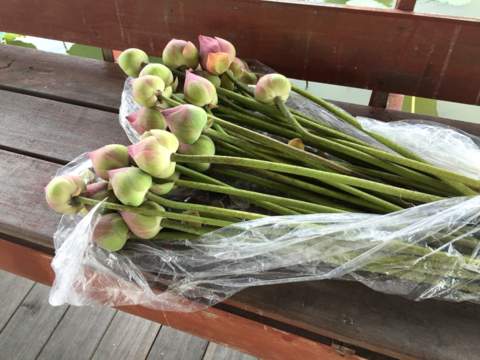
The lotus flowers The process is repeated section by section throughout the entire pond. This will ensure that there will still be some plants producing flowers and generating income. 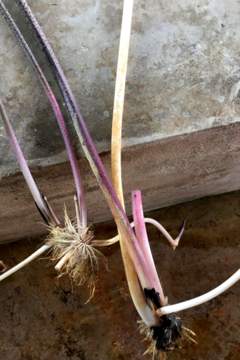
The young stems of the lotus leaves are used to cook a Thai stew, kaang som. Table of contents Processed agricultural products This community called Baan Saladin has a centre that teaches residents various skills that help them augment their income. This activity is organised by the Mahasawat Farm Women’s Group. Various processed goods made from agricultural products sold here. Residents are taught cooking, coffee brewing, sewing, making salted ducks’ eggs, dried bananas, various sweets and deserts and even making fertiliser! 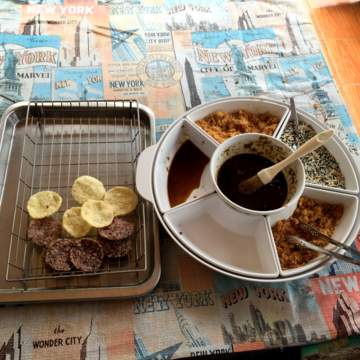
Rice crackers with various sauces Here’s an interesting account of how the community copes with environmental protection. The Mahasawat Canal is frequently choked with water hyacinth which impedes the flow of fresh water from the Tha Chin River. The stagnant water becomes a breeding ground for mosquitoes, bacteria, and other parasites. Surface vegetation also causes deoxygenation which kills fish and algae and results in contamination. The community encourages the removal of the water hyacinth by buying these vegetables from residents at 20 baht per kilogram. The water hyacinth is dried in the sun, grinded, mixed with earth, husk and treated animal manure then packed and sold as fertiliser to the surrounding farms. This will prevent pollution of the waterways by other kinds of non-organic and chemical fertilisers. This ongoing effort has helped keep the Mahasawat Canal relatively clean. 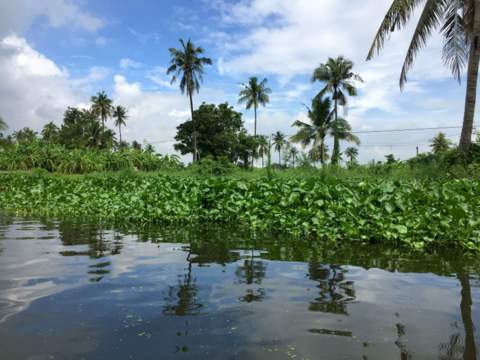
Keeping the water clean 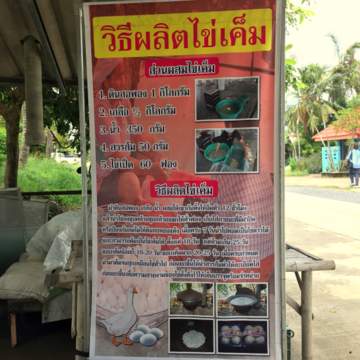
Learn how to make salted ducks’ eggs 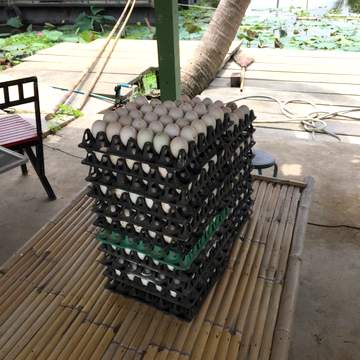
The finished products 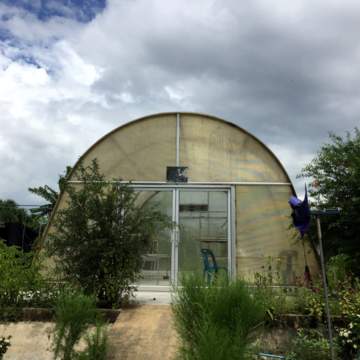
Greenhouse for drying bananas It’s a convenient stop to have a break of tom yam noodles, coconut desert and traditional coffee by the Mahasawat Canal at very reasonable prices, unheard of in Bangkok! 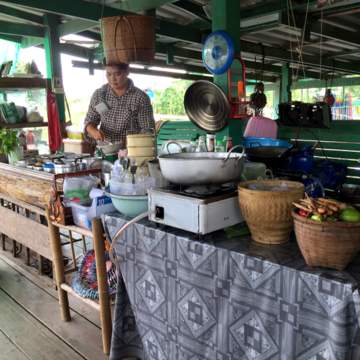
Noodles by the canal 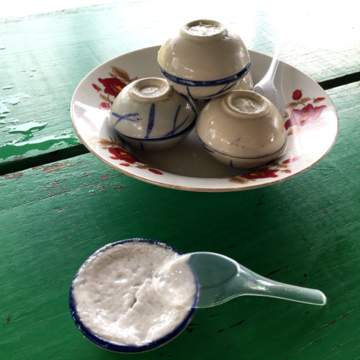
Coconut desert – 2 for 5 baht As we left this place, we spotted the only lotus flower in bloom. 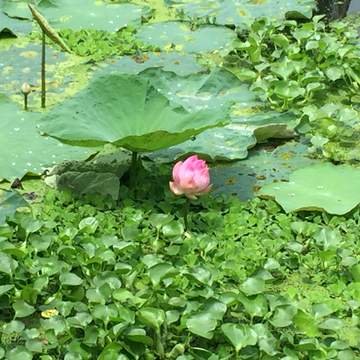
The only lotus flower we saw along the way Table of contents Fak kao or red melon farm This bright orange fruit is called Momordica Chochinchinensis and the common names in the following languages are mu bie guo – Chinese, red melon – English, fak kao – Thai, gac – Vietnamese. This fruit helps improve eyesight, lower cholesterol, prevents cancer and provides a host of other benefits. 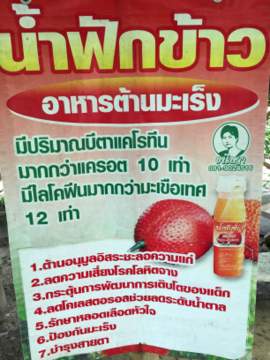
The benefits of the red melon The fruit grows from vines that creep on lattices or wooden vertical and horizontal frames. The vines are grown from the seeds of the fruit. It takes about six months from the time the seed is planted to the time the vines bear fruit. 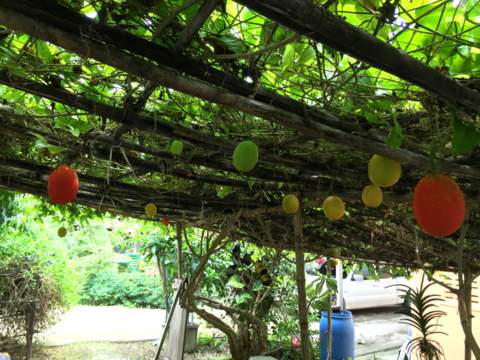
The red melon garden 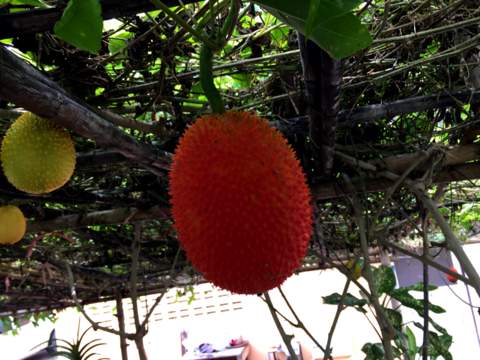
Close up of the fruit – it’s prickly The juice made from this fruit is delicious and is sold in plastic bottles at 50 baht for six bottles. 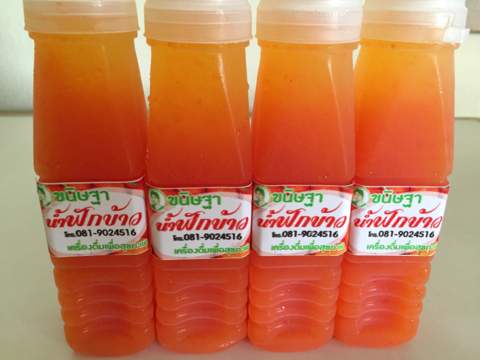
Red melon juice Table of contents Orchid farm Beautiful multi-coloured orchids were in full bloom at the orchid farm we visited. These lovely orchids are grown for the local and export markets. You can buy some orchids flowers or the entire plant. 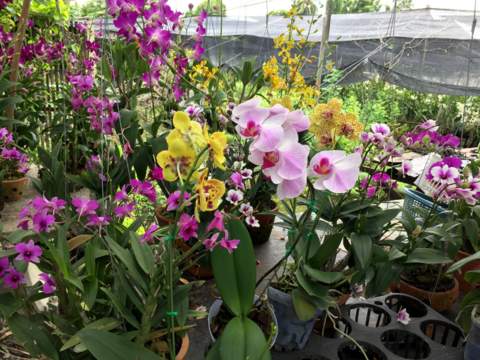
Some of the colourful blooms on sale The paths between the rows of orchids were extremely muddy though due to the rain that morning. Just imagine in 2011 when heavy floods hit this area, the water level rose to 1.6 m or 5 ft 3 in. Most of these farms were wiped out. 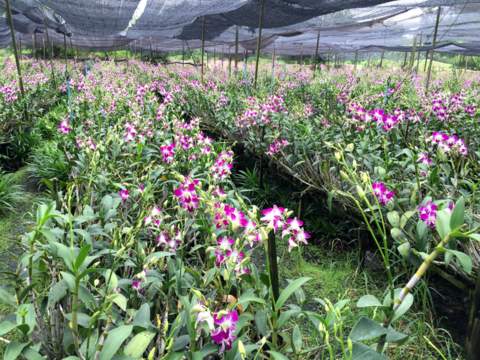
The orchid farm 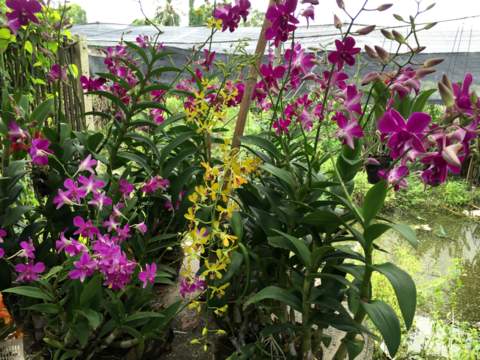
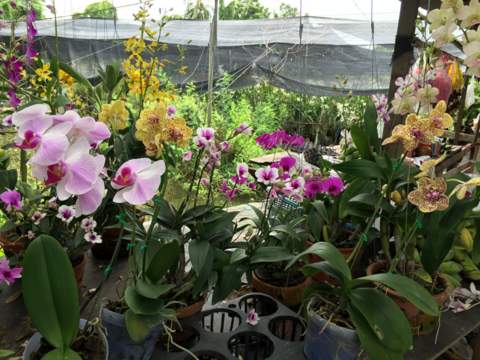
Simply dazzling Table of contents Orchard and rice farm The best is kept till last. Here at this orchard and rice farm it was hospitality at its best. Fruits and deserts were served to visitors. It’s a huge farm, about 80 rai (12.8 hectares or 31.6 acres) half are orchards and the other half rice fields. The orchards produce among other fruits, bananas, lemons, mangoes and mangosteens. 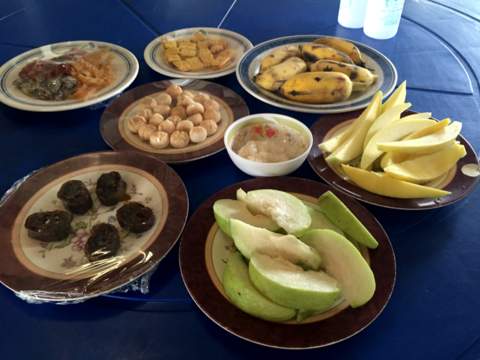
Deserts of bananas, guavas and mangoes The highlight of this visit is the "ee-tenn" ride through the farm. The "ee-tenn" is a tractor that’s hooked onto a passenger trailer with two rows of seats facing each other. 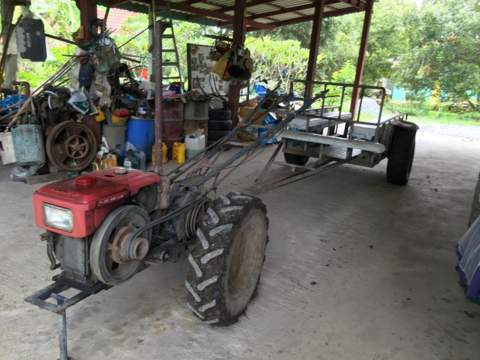
Ee-tenn, a tractor pulling a passenger carriage This ride is optional but it’s highly recommended if your heart can take it. The ride takes you through narrow lanes with sharp right angled turns with a ditch on one side. The guy operating this is very skilful; just wait till he makes a U-turn with this contraption! 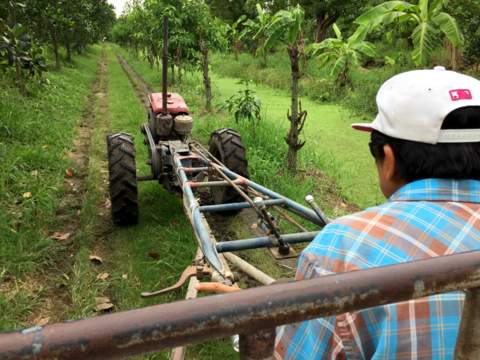
A ride through the orchards 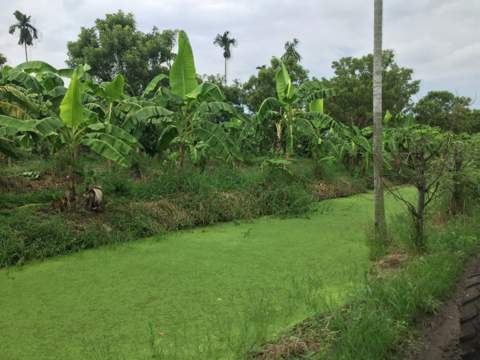
With a ditch on your left 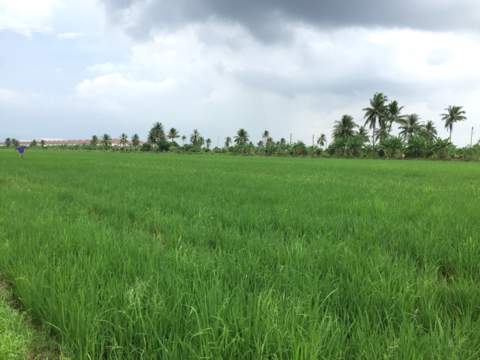
And rice fields To make a U-turn at the end of track, he has to jump off the tractor, swing the steering levers at right angles to the vehicle, run to make the U-turn, then jump back into driver’s seat when the vehicle straightens out. You got to try it out for the experience!! Table of contents Our boat operator and guide Pi Ya our host, boat operator and guide is one great lady! She’s knowledgeable, cheerful and made all the difference to a thoroughly enjoyable tour. Always ready with a hearty laugh and cheerful greeting, she’s a resident on the Mahasawat Canal and knows everyone in the neighbourhood. 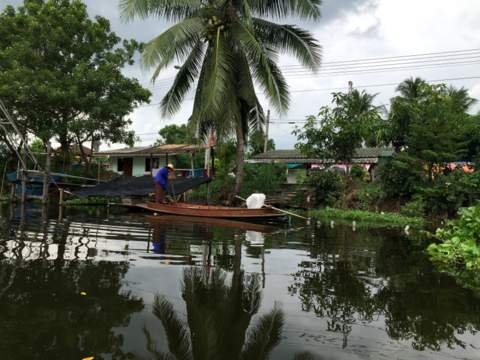
Life on the Mahasawat Canal She pointed out her home to us when we passed a wooden house by the canal, stopped by and got us some ice cold coconut juice and shavings neatly packed in plastic bags. 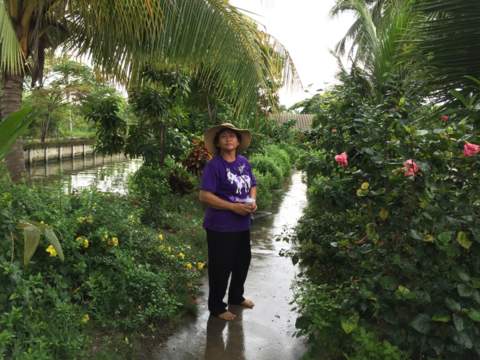
A big thank you to Pi Ya We are grateful to her for some of the information she had imparted concerning farming in the area. What’s most admirably about her is that through her hard work she has raised two daughters through university. That is the best any parent can do, to prepare their children for life! We wish you and your family all the best Pi Ya! Table of contents Map of the Mahasawat Canal boat tour Click on this link for a bigger map How to get to Wat Suwannaram Cross to the west bank of the Chao Phraya River at the Phra Pinklao Bridge and get onto Borommarachachonani Road. Alternatively, cross at the Taksin Bridge - Ratchapruek Road - Borommarachachonani Road. Avoid Phetkasem Road to the south because of the congestion caused by the train line construction. Turn right into Phutthamonthon Sai 4, head due north till you reach the clock tower at Salaya. Turn left into Highway 4006 and travel for about five km turn right to Wat Suwannaram. Follow the signboards in this narrow lane, cross over the railway track, turn right and continue on till you get to the temple. Prices Cost of hiring the long-tailed boat – 350 baht, the boat takes six adults of medium built, there’s no time limit and you get to visit all five places at a leisurely pace. Cost of touring the various places – 70 baht per head, this is for the refreshment and snacks. Cost of the ee-tenn or tractor ride – 80 baht, this is optional. Contact Information Address Agrotourism Service Centre Wat Suwanaram Salaya – Nakhon Chaisi Road Tambon (sub-district) Mahasawat Amphur (district) Phuttamonthon Nakhon Pathom Thailand Tel: 08 1495 9091, 08 1743 5850, 08 9551 4623, 034 297 152, When calling from overseas, drop the 0 and add + 66 Table of contents Next month Thai Rice Farmers Museum, Nakhon Pathom If you enjoyed reading this e-zine, please forward it to a friend. If you received this from a friend and found it interesting, please subscribe at Bangkok Travelbug. What do you think of the Bangkok Travelbug? We love to hear from you What other subscribers have said Till next month then. Eric Lim Tour Bangkok Legacies Find us on Facebook Copyright@2008-2015 Tour Bangkok Legacies All rights reserved |
| Back to Back Issues Page |
